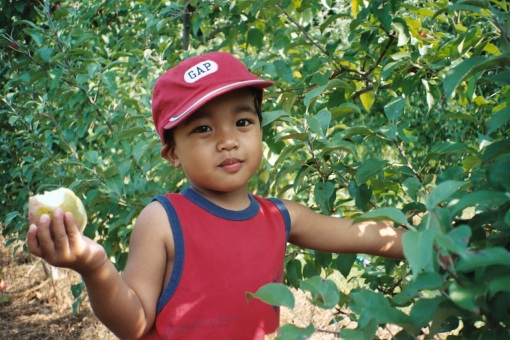Last week’s Ladybug Blog extolled the historical, cultural, and culinary delights of pumpkin. It seems as though you can’t step foot into a grocery store, candle shop, or cafe without being inundated with products that revolve around pumpkin spice. As ubiquitous as the combination of cinnamon, clove, and allspice have been the past few years I remember a time when the flavor of early fall was apple; from cider and cider doughnuts to pies and apple butter.
Many a school field trip or family outing revolved around a trip to an orchard to pick one of the many varieties of apples available in New England and return home laden with bags of this versatile fruit. The pleasure of these adventures was increased if the destination also had a working cider press. That sweet/sour smell of the overripe apples being pressed says fall much in the same way that a freshly-cut fir tree hints that Christmas is on its way.

Enjoying a visit to Easy Pickins Orchard in Enfield, CT
Apple orchards have been a part of Connecticut and New England since cultivated apples (Malus pumila also known as M. domestica) were brought here by the European settlers in the 17th century. The first recorded apple orchard was planted in 1625 by the Reverend William Blaxton in what is now Cumberland, Rhode Island. Reverend Buxton cultivated the Yellow Sweeting apple which later became known as the Rhode Island Greening, a cooking apple that has a greenish-yellow flesh. Before that only the small, sour, wild apples which we know as crabapples grew in North America. Crabapples are used as ornamental trees in landscapes and as they are heavy bloomers are great sources of pollen for cross-pollination in apple orchards, are a good source of pectin, and as a rootstock that provides cold-hardiness to domestic apples.

The crabapple tree at our first home bloomed beautifully every Mother’s Day (1991)
The use of crabapple or other apple varieties as a rootstock in grafting is very important in modern orchard farming. Apple trees grown from seed do not grow true to their parent plant and can be anywhere from 12 to 36’ tall, features that are not conducive to consistent apple production and ease of harvest. Therefore, grafting, the technique that combines the beneficial traits of 2 or 3 apple varieties is greatly beneficial. In the simplest of terms, grafting is the procedure by which a scion (a piece of last year’s growth that has 2-3 buds) is cut from an existing tree of the desired apple variety.
The scion is inserted into the cambium (vascular) layer of the understock (rootstock) of another apple variety that may bring traits such as disease resistance, crotch strength, adaptability to heavier soil, a slow growth rate, adaptability to espalier training, or the above-mentioned cold-hardiness. The new graft is generally bound with tape and a grafting compound. Detailed information on grafting can be found in books or online.

Espaliered apple trees
Cider apples are usually a combination of cultivars that are grown specifically for use in cider production to have higher sugar and tannin levels and are often more astringent than the eating and baking varieties. These qualities contribute to a final product that has a deeper flavor. Among cider apple varieties are some that are higher in sugar which causes their cider product to ferment resulting in hard cider. In fact, hard cider was an important beverage at a time when refrigeration was unavailable. Most apple cider produced today is pasteurized, a process that heats the unfiltered apple juice to prevent bacterial contamination. It also destroys any yeast that would cause the juice to ferment creating a more stable non-alcoholic product. In fact, ‘Johnny Appleseed’, the folklore hero born as John Chapman in 1774, planted seeds that produced apples that were only good for hard cider (or applejack), not for eating.
In 1993 The Enfield Historical Society brought a manual cider press to the Old Town Hall Museum. Since we were members of the Society my husband Russ and some friends were enlisted to turn the press.

Layers of burlap-wrapped apples are squeezed in the manual cider press.
It was a beautiful, sunny fall day, perfect for an outdoor exhibition. Our children and friends were among the crowd that gathered to watch the action. The resultant cider was not distributed as it had not been pasteurized but there were jugs of pre-pressed cider for the enjoyment of all.

Crates of apples await their turn in the press.
Humans are not the only members of the animal kingdom that appreciate ripening apples. At this time of year, it is almost impossible to get near an apple tree without being in the presence of yellowjacket wasps as they forage for the sugars that are important to their developing queen in late summer. As overly ripe apples fall to the ground the yellowjackets will swarm the fallen fruit.
A beautiful Mutsu apple showed the scars of an encounter with yet another species that wanted to feed on the delicious ripening fruit. Although this apple was about 5 feet above the ground an animal, possibly a raccoon, had attempted unsuccessfully to get it.

Mutsu apple with animal damage.
We, however, picked many Mutsu (also known as Crispin) apples, a very crunchy and sweet variety that is a cross between the Golden Delicious and the Indo cultivars that is great for eating and several pounds of Cortland destined for pies, crisps, and apple butter. Connecticut’s orchards are still going strong so visit the Connecticut Apples site to find one near you and enjoy some of the many delicious varieties that are grown in our state.
Susan Pelton








October 25, 2017 at 2:26 am
A good article. Thank you. Too bad so many cider Mills have disappeared.